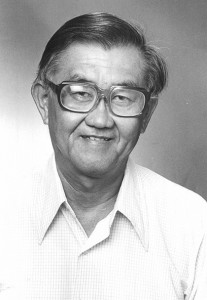 Furumoto died Nov. 14 at the age of 87.
Furumoto was part of a small group of distinguished scientists who helped to bring the University of Hawaii's Department of Geology and Geophysics and the nascent Hawaii Institute of Geophysics to prominence in the 1960s.
In 1964, Furumoto and colleagues Doak Cox and Ralph Moberly were tasked with investigating a powerful earthquake that hit the Aleutian Islands and the tsunami that was produced as a result. As part of this project, Furumoto and George Pararas-Carayannis wrote an influential report on tsunami generation.
A year later, Furumoto was tapped to be part of the newly formed Joint Tsunami Research Effort, a partnership between UH and the U.S. Coast and Geodetic Survey.
Through his groundbreaking research, Furumoto was able to develop a method for evaluating the tsunami risk to Hawaii based on an earthquake's source, a key component in providing early warning of potential tsunami action.
In 1999, Furumoto was one of five scientists honored by the International Tsunami Society for their contributions to tsunami research.
Furumoto is survived by wife Chieko, son Gregory, daughter Anne Shintaku, brother Warren, sisters Grace Zukeran and Elaine Furumoto, and two grandchildren.
Services will be private.
Furumoto died Nov. 14 at the age of 87.
Furumoto was part of a small group of distinguished scientists who helped to bring the University of Hawaii's Department of Geology and Geophysics and the nascent Hawaii Institute of Geophysics to prominence in the 1960s.
In 1964, Furumoto and colleagues Doak Cox and Ralph Moberly were tasked with investigating a powerful earthquake that hit the Aleutian Islands and the tsunami that was produced as a result. As part of this project, Furumoto and George Pararas-Carayannis wrote an influential report on tsunami generation.
A year later, Furumoto was tapped to be part of the newly formed Joint Tsunami Research Effort, a partnership between UH and the U.S. Coast and Geodetic Survey.
Through his groundbreaking research, Furumoto was able to develop a method for evaluating the tsunami risk to Hawaii based on an earthquake's source, a key component in providing early warning of potential tsunami action.
In 1999, Furumoto was one of five scientists honored by the International Tsunami Society for their contributions to tsunami research.
Furumoto is survived by wife Chieko, son Gregory, daughter Anne Shintaku, brother Warren, sisters Grace Zukeran and Elaine Furumoto, and two grandchildren.
Services will be private.

 Furumoto died Nov. 14 at the age of 87.
Furumoto was part of a small group of distinguished scientists who helped to bring the University of Hawaii's Department of Geology and Geophysics and the nascent Hawaii Institute of Geophysics to prominence in the 1960s.
In 1964, Furumoto and colleagues Doak Cox and Ralph Moberly were tasked with investigating a powerful earthquake that hit the Aleutian Islands and the tsunami that was produced as a result. As part of this project, Furumoto and George Pararas-Carayannis wrote an influential report on tsunami generation.
A year later, Furumoto was tapped to be part of the newly formed Joint Tsunami Research Effort, a partnership between UH and the U.S. Coast and Geodetic Survey.
Through his groundbreaking research, Furumoto was able to develop a method for evaluating the tsunami risk to Hawaii based on an earthquake's source, a key component in providing early warning of potential tsunami action.
In 1999, Furumoto was one of five scientists honored by the International Tsunami Society for their contributions to tsunami research.
Furumoto is survived by wife Chieko, son Gregory, daughter Anne Shintaku, brother Warren, sisters Grace Zukeran and Elaine Furumoto, and two grandchildren.
Services will be private.
Furumoto died Nov. 14 at the age of 87.
Furumoto was part of a small group of distinguished scientists who helped to bring the University of Hawaii's Department of Geology and Geophysics and the nascent Hawaii Institute of Geophysics to prominence in the 1960s.
In 1964, Furumoto and colleagues Doak Cox and Ralph Moberly were tasked with investigating a powerful earthquake that hit the Aleutian Islands and the tsunami that was produced as a result. As part of this project, Furumoto and George Pararas-Carayannis wrote an influential report on tsunami generation.
A year later, Furumoto was tapped to be part of the newly formed Joint Tsunami Research Effort, a partnership between UH and the U.S. Coast and Geodetic Survey.
Through his groundbreaking research, Furumoto was able to develop a method for evaluating the tsunami risk to Hawaii based on an earthquake's source, a key component in providing early warning of potential tsunami action.
In 1999, Furumoto was one of five scientists honored by the International Tsunami Society for their contributions to tsunami research.
Furumoto is survived by wife Chieko, son Gregory, daughter Anne Shintaku, brother Warren, sisters Grace Zukeran and Elaine Furumoto, and two grandchildren.
Services will be private.
Our deepest condolences to the family and friends of the deceased


